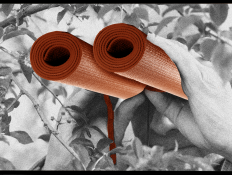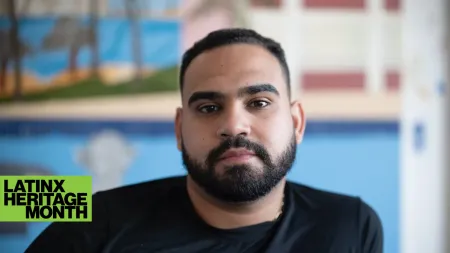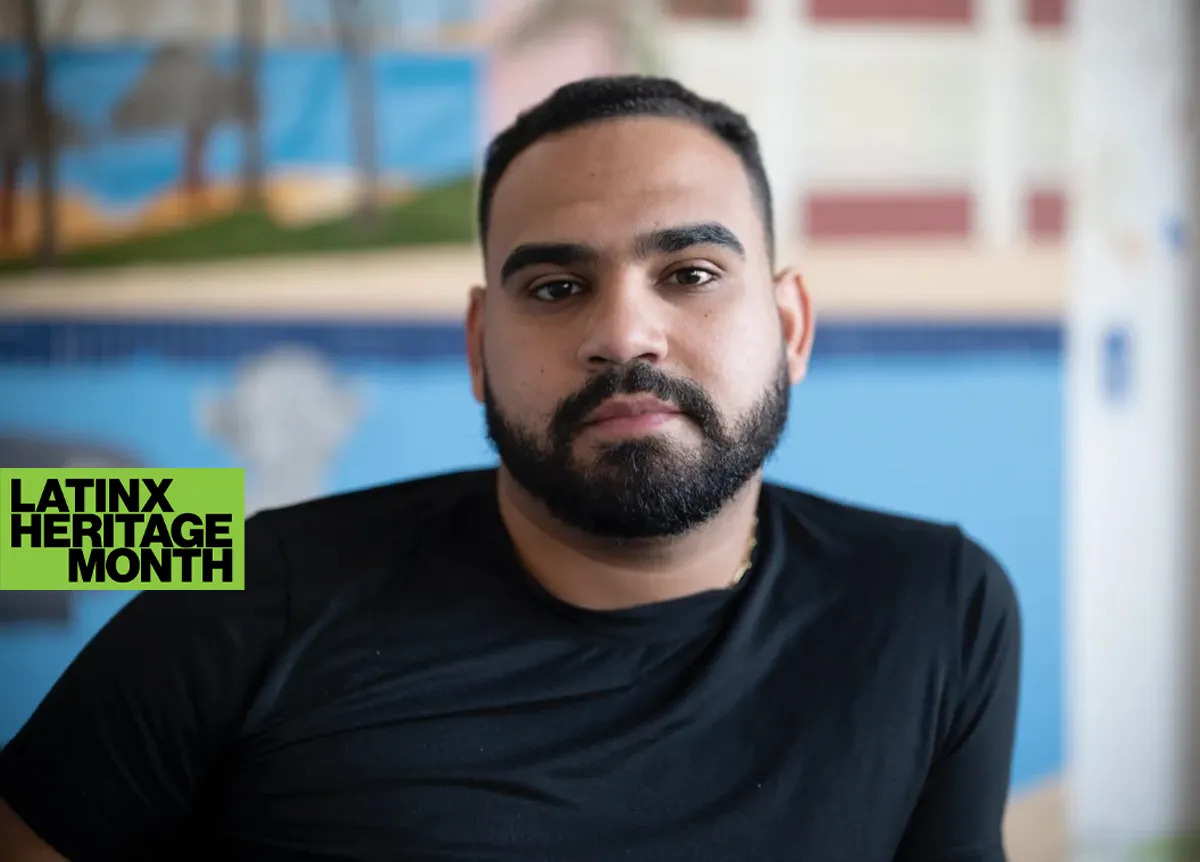
“I thought about how orchids in general are [like] these beautiful parasites that attach themselves to trees and don’t exactly bring anything positive to them,” artist Bony Ramirez told ARTnews during a recent interview. “They’re just occupying space, which can be closely related to Spanish colonialism and toxic parts of tourism in the Caribbean.”
As part of a yearlong residency at the Newark Museum of Art in New Jersey, Ramirez developed a body of work that is in dialogue with the institution’s permanent collection, and that will feature in his first solo museum exhibition, “Cattleya” (through March 9). Inspired by Martin Johnson Heade’s Cattleya Orchid with Two Hummingbirds (ca. 1880s), which blurs the line between still life and landscape painting, Ramirez created several mixed-media paintings that focus on the legacies of colonialism, particularly through the lens of tourism.
The exhibition opens with an installation of a suspended taxidermy calf wrapped in metal chains that attach to all the sides of its coral pink background; seashells hang on each end of the chains. Titled Sitting on a Bucket of Paint (Self-Portrait as a Calf), the calf, standing in for Ramirez, represents the labor—itself a prison—that goes into creating a paradise in the Caribbean for others.
The exhibition’s other bookend is a large portrait, titled Cattleya (all works 2024),showing an aristocratic mulatto woman who wears a large, dark-colored flower gown with puffy white sleeves. She is blind in one eye and her face is distorted; her black hair is styled to resemble horns, one of which is decorated with a Cattleya orchid. She holds the head of a bleeding chicken in one hand, and its body in the other. Between the calf and the woman are works that weave the story of Caribbean life from the start of colonialism to the present, where a mixed-race populace still deals with the aftereffects of domination. Ramirez’s style is magical realism with hints of surrealism, attempting to play in between fantasy and reality, a feeling that is strongly transmitted in this exhibition.
“I was never the kind of artist interested too much in everyday life,” he said, “but more so in creating my own narrative and my own world about the symbolism and different things that the Caribbean is known for. I wanted to create a reality that helps you escape your own, but … also [be] confronted by it.”
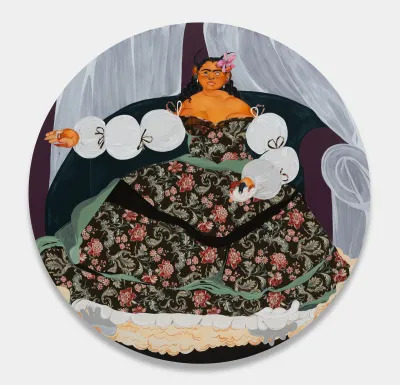
Ramirez is a self-taught artist who was born and raised in a small town in the Dominican Republic and immigrated to Perth Amboy, New Jersey, with his mother and little brother in 2009, at the age of 13. In 2014 the Newark Museum of Art was the first museum he ever visited, and Heade’s painting among the first he connected with. “I resonated with the painting because it was almost the only thing that I felt was very tropical and close to me,” Ramirez recalled a decade later.
Because Ramirez did not attend art school, he said that experience gave him the freedom to experiment. “Looking back at it, it’s one thing that helped me come up with my own style because I really didn’t have that molding from somebody else or a teacher. I really had to look at it on my own,” he said.
Hanging next to the chained calf is Cuánto Daría, Simplemente Amigos (How Much I’d Give, Just Friends, 1988), a painting of two men in a sugarcane field hugging, with a machete sitting on top of the painting. The two works, presented side by side, speak to captivity. In Cuánto Daría, two men yearn for each other. There’s an intimacy here that is likely unreachable. They are possibly trapped in their own queerness and desires, as they are forced to work in some of the most strenuous labor that colonialism has inflicted.
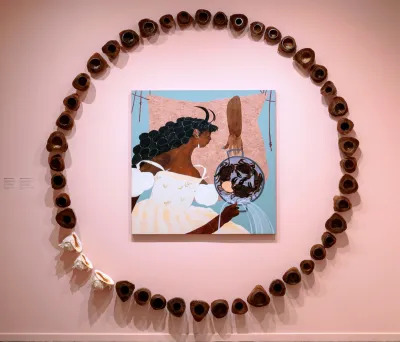
In the next room, a sculpture comprising a circle of coconuts and three conch shells, and titled Coral, Coconut Portal, frames another painting, Allegory of Liberation, showing a dark-skinned girl with horns and flowing black hair. She holds a large potwith several crabs, symbols of resilience and adaptability. The sculptural portal can be viewed as an invitation to enter the artist’s mix of fantasy and reality or simply to peer through.
Elsewhere is The Epiphytes, a painting of three girls of various skin tones playing a hand game. Cattleyas are epiphytes, plants that grow on the surface of another plant; they enhance the biodiversity of their ecosystems. They are generative rather than extractive. Across from Epiphytes sits a distorted-looking baby in a crib. The infant has horns too; scenes of the ocean are painted in his ears, and coconut shells surround his long white fingers and toes.
Nearby is the exhibition’s tour de force, Caribe Express/Caribe Tours, a 27-foot-wide painting that shows men in vejigante masks serving tourists who lounge in a resort’s glistening pool. Vejigante masks date as far back as 17th-century Spain; typically representing demonic figures, they are a means to scare people into attending Sunday mass. Today, they are commonplace in the DR during carnival. In Ramirez’s tableau, the tourists are rendered as silhouettes filled with grisaille landscapes, while the servers’ covered faces make them mere caricatures, rendering them invisible in this paradisiacal destination that is, in fact, their homeland.
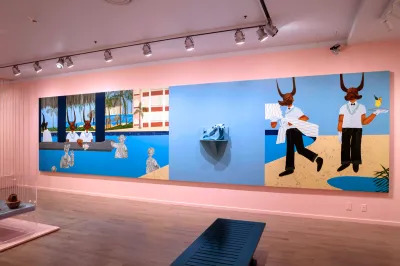
“We live off tourism; it’s our biggest export,” Ramirez said. “I wanted to focus more on tourism’s effects [since] Covid. Many smaller countries like the Dominican Republic didn’t have as many travel regulations for foreigners because they [needed] people to come. But then people that lived in the country had to wear their masks and had to get tested [regularly]. A lot of the time it was our own countries putting our own people in danger. People from the outside didn’t think about [those] who actually live on the island and how they are affected by [tourism].”
The violence of tourism—subtle and not so subtle—is the aftereffect of colonialism in an economy developed still to be extractive and to persist in forcing the local people into new forms of servitude. But Ramirez sees hope and resilience in these works.
“For anybody from the Caribbean that goes to see the show, I want them to see themselves reflected in the show, see part of their culture, and see themselves in the paintings and sculptures as well,” he said. “A lot of the pieces in the show are really in your face. They’re a little difficult to deal with. I wanted the viewer to confront the realities of the world. That is, that the Caribbean is not just this beautiful paradise. There’s a lot of stuff that goes on behind the scenes that a lot of tourists tend to overlook.”
A Bracing Retrospective of Carlos Villa Shows Just How Prescient the Artist’s World Making Is for Today’s Artists and Thinkers
Thomas Cole Painting Controversially Sold by Newark Museum Heads to Philadelphia
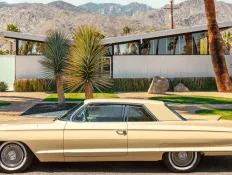
This New Coffee Table Book Explores the Lines Between Captivating Cars and Great Architecture

Michelle Obama Suits Up With Contemporary Edge in Versace’s Safety-pin Blazer for George Clooney’s Albie Awards 2024

Best smart locks, based on extensive expert testing

Gambling-Fueled Connecticut Sun Eye First WNBA Title
